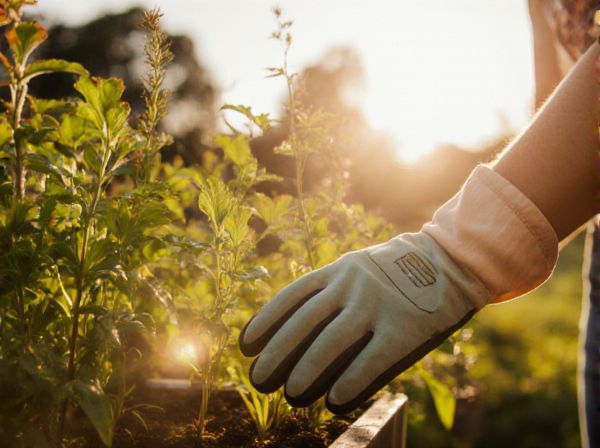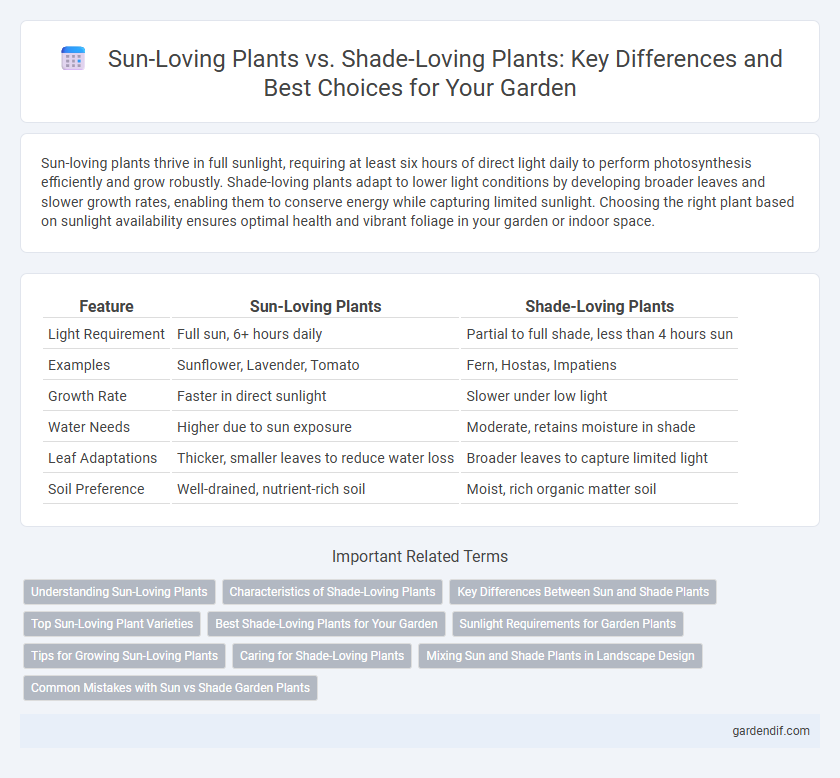
Sun-loving plants vs shade-loving plants Illustration
Sun-loving plants thrive in full sunlight, requiring at least six hours of direct light daily to perform photosynthesis efficiently and grow robustly. Shade-loving plants adapt to lower light conditions by developing broader leaves and slower growth rates, enabling them to conserve energy while capturing limited sunlight. Choosing the right plant based on sunlight availability ensures optimal health and vibrant foliage in your garden or indoor space.
Table of Comparison
| Feature | Sun-Loving Plants | Shade-Loving Plants |
|---|---|---|
| Light Requirement | Full sun, 6+ hours daily | Partial to full shade, less than 4 hours sun |
| Examples | Sunflower, Lavender, Tomato | Fern, Hostas, Impatiens |
| Growth Rate | Faster in direct sunlight | Slower under low light |
| Water Needs | Higher due to sun exposure | Moderate, retains moisture in shade |
| Leaf Adaptations | Thicker, smaller leaves to reduce water loss | Broader leaves to capture limited light |
| Soil Preference | Well-drained, nutrient-rich soil | Moist, rich organic matter soil |
Understanding Sun-Loving Plants
Sun-loving plants thrive in environments with at least six hours of direct sunlight daily, which supports their photosynthesis and vigorous growth. Examples include tomatoes, lavender, and sunflowers, all adapted to maximize energy absorption from intense light. These plants typically have thicker leaves and deep root systems to manage water efficiently under bright, dry conditions.
Characteristics of Shade-Loving Plants
Shade-loving plants thrive in low-light environments and often have larger, thinner leaves to maximize photosynthesis in limited sunlight. These plants typically exhibit slower growth rates and possess adaptations such as higher chlorophyll content for efficient light absorption. Common examples include ferns, hostas, and caladiums, which prefer moist, well-drained soils and shaded garden areas.
Key Differences Between Sun and Shade Plants
Sun-loving plants require at least six hours of direct sunlight daily, thriving with intense light to perform photosynthesis efficiently, while shade-loving plants adapt to low light conditions with broader, thinner leaves to capture diffuse sunlight. Sun plants typically have a higher tolerance for drought and heat, featuring thicker, waxy leaves that reduce moisture loss, whereas shade plants often exhibit higher moisture requirements and thinner, more delicate foliage. Growth patterns also differ: sun-loving species tend to develop compact, robust forms, whereas shade-loving plants often grow taller and leggier as they stretch towards available light.
Top Sun-Loving Plant Varieties
Top sun-loving plant varieties thrive in full sunlight, exhibiting vibrant blooms and robust growth due to their high photosynthetic activity. Popular sun-loving plants include lavender, known for its fragrant purple flowers and drought tolerance, sunflower with its iconic large yellow heads, and marigolds which deter pests while adding bright colors. These plants require well-drained soil and consistent exposure to at least 6 hours of direct sun daily to maximize their health and flowering potential.
Best Shade-Loving Plants for Your Garden
Best shade-loving plants for your garden include hostas, ferns, and astilbes, thriving in low-light conditions and adding lush greenery. These plants adapt well to shaded areas, improving soil moisture retention and reducing erosion. Selecting shade-tolerant species enhances garden biodiversity and creates a tranquil, cool environment.
Sunlight Requirements for Garden Plants
Sun-loving plants require at least six hours of direct sunlight daily to thrive, making them ideal for open, sunny garden areas. Shade-loving plants prefer less than four hours of direct sunlight, often flourishing under tree canopies or in north-facing garden spots. Understanding these sunlight requirements ensures optimal growth and vibrant foliage for both plant types in diverse garden settings.
Tips for Growing Sun-Loving Plants
Sun-loving plants thrive in direct sunlight for at least six hours daily, requiring well-drained soil and regular watering to prevent wilting. Select drought-tolerant species like lavender, marigold, and rosemary to maximize growth in full sun conditions. Use mulch to retain moisture and protect roots from heat stress, ensuring optimal health for sun-loving plants.
Caring for Shade-Loving Plants
Shade-loving plants thrive in low-light environments and require careful watering to avoid root rot, especially in poorly drained soils. These plants generally prefer rich, well-draining organic matter that retains moisture without becoming soggy, supporting healthy growth. Regular monitoring of humidity and protection from direct sunlight helps maintain vibrant foliage and prevents leaf scorch.
Mixing Sun and Shade Plants in Landscape Design
Mixing sun-loving plants such as lavender, marigolds, and sunflowers with shade-tolerant species like hostas, ferns, and astilbes creates dynamic, visually appealing landscapes that thrive in varied light conditions. Strategic placement based on each plant's sunlight requirements enhances growth, reduces maintenance, and promotes biodiversity. Incorporating both sun and shade plants optimizes garden space, improves microclimates, and attracts diverse pollinators for a balanced ecosystem.
Common Mistakes with Sun vs Shade Garden Plants
Sun-loving plants often suffer from overwatering and insufficient sunlight when mistakenly placed in shaded areas, leading to weak growth and poor flowering. Shade-loving plants frequently face leaf scorch and dehydration if planted in full sun without adequate moisture management. Understanding the specific light requirements and watering needs of each plant type prevents common garden failures and promotes healthy, vibrant plant development.
Sun-loving plants vs shade-loving plants Infographic

 gardendif.com
gardendif.com